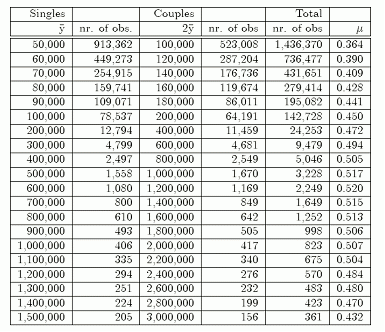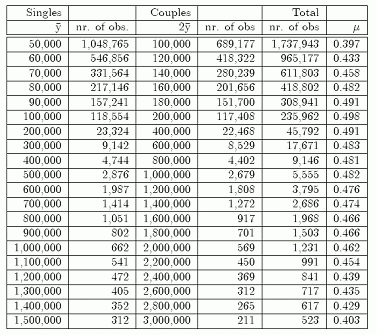Governments striving for balanced budgets should try to get the money from those who have it. According to a large body of empirical research summarised by Atkinson and Piketty (2010), the place where the money lies is increasingly the top of the income distribution. However, taxing the rich is a notoriously difficult task and overambitious policies may “kill the goose that lays the golden eggs”. So, what is the best tax rate on top incomes if we want to maximise the tax revenue for the government?
New insight from Germany
In a recent discussion paper (Bach et al. 2011), we attack that issue for the case of Germany. Similarly to other countries, the German income tax code includes a top marginal tax rate that applies to incomes above a certain threshold. We would like to assess two things:
- What the optimal level of the top marginal tax rate is, and
- Where the optimal income threshold lies.
A useful starting point is an optimal tax formula suggested by Saez (2001). It implies that the optimal top marginal tax rate is a function of substitution and income effects of labour supply and depends on the thickness of the top tail of the income distribution. However, that formula is only valid for individual income taxation, while in Germany there is joint taxation with income splitting for spouses. The spouses' incomes are added together and taxed as if each earned one half of the total. For couples, the income threshold for taxation at the top marginal tax rate is twice the level that applies to single taxpayers. So, in the case of Germany, determining the optimal top marginal tax rate requires knowledge of the distributions of top incomes of singles and couples separately.
We have computed those distributions using a large sample of official individual tax returns that includes all taxpayers in the top percentile of the German income distribution in 2005. For that year, Table 1 portrays the distributions of top wage income for, respectively, singles and couples. Table 2 displays the corresponding top distributions of the sum of wage income and professional income. The tables show the number of tax units with taxable income in excess of a given threshold. Looking at those top distributions more closely reveals that they are fitted remarkably well by a Pareto distribution with an
-parameter of about 2.
Table 1. Taxable wage income
Table 2. Taxable wage and professional income
In order to compute the responses of top taxpayers to the top marginal tax rate, we have evaluated their labour-supply behaviour – both along the intensive and the extensive margin – using data from the German Socio-Economic Panel. It turns out that singles with income in excess of €50,000 a year have on average uncompensated labour-supply elasticity of 0.14; for couples with incomes larger than €100,000 the corresponding elasticity is 0.18. The income effects are, respectively, -0.06 and -0.02.
Results obtained by applying the optimal tax formula to the German data are shown in Table 3. Computations of the optimal top tax rate take into account that not only income but also consumption is taxed in Germany. For any level of the income threshold, Table 3 indicates the top marginal tax rate that maximises tax revenue once the loss of tax base due to decreased work incentives is taken into account. Thus, if the income threshold for taxation at the top rate is set at €50,000 (€100,000 for couples), the optimal top tax rate on income is about 56 % if one merely considers wage income and it is 60% if one also considers professional income. For both income concepts, the optimal tax rate converges to a level of about 2/3 at an income threshold of roughly €350,000. Therefore, setting the top marginal tax rate at 67% for yearly incomes in excess of €350,000 (€700,000 for couples) seems to be optimal from the viewpoint of public finances.
Far from optimal
That finding suggests that actual taxation of top incomes in Germany is far from the optimal level associated with the maximum of the Laffer curve. In 2005, the top marginal tax rate in Germany, including the so called solidarity surcharge ("Solidaritaetszuschlag"), was about 45% and started at an income level of about €50,000 for singles and €100,000 for couples. Since 2007 there is an additional tax surcharge ("Reichensteuer") for incomes above €250,000 (€500,000 for couples); the resulting top marginal tax rate is about 48%.
Table 3. Optimal top marginal income tax rates for various thresholds and various income concepts
The relatively high optimal top marginal tax rate that we found for Germany is likely to be close to optimal top tax rates in other advanced economies. First, the Pareto distributions of top incomes in other OECD-countries seem to have an
-parameter close to 2, the value we obtained for Germany. Second, the incentive effects of taxation on labour supply seem to show little variation across rich countries.
Why are top rates of tax below optimal?
Why are top marginal tax rates in those countries and particularly in Europe some 20 percentage points below those that maximise tax revenue? Part of the answer may simply be that incumbent governments do no want to maximise tax revenue from the rich, possibly because politicians are intimately linked with the rich through “revolving doors”. It may also be that the treasury would not profit from raising the top marginal tax rate if the government doing so does it alone. The theoretical model used to determine the optimal asymptotic tax rate posits a closed economy without international migration of top earners. As suggested by Simula and Trannoy (2010) among others, taking potential losses of tax base due to migration into account can significantly reduce the level of the optimal top marginal tax rate.
Given their common fiscal problems and a common rise of income concentration over the last years, EU member countries may benefit from coordinating their taxation of top incomes. A natural policy option is to agree on a minimum top marginal tax rate that starts in each country at an income level defined as a common multiple of that country’s per-capita national income. Reaching such an agreement would not be easy, as past experiences in the realm of corporate and capital income taxation suggest. Difficult issues about tax base and tax audits would also have to be tackled. But eventual success would greatly improve the efficacy and efficiency of the income tax to raise governmental revenues in the EU.
References
Atkinson, A and T Piketty (2010), Top Incomes – A Global Perspective, Oxford University Press.
Bach, S, G Corneo, and V Steiner (2011), “Optimal top marginal tax rates under income splitting for couples”, CEPR Discussion Paper 8435.
Saez, E (2001), “Using elasticities to derive optimal income tax rates”, Review of Economic Studies, 68:205-229.
Simula, L and A Trannoy (2010), “Optimal income tax under the threat of migration by top-income earners”, Journal of Public Economics, 94:163-173.









